In 1999, I wrote, “Was it only last year that Apple went from beleaguered to industry darling? Released the amazing iMac? Ran a profit every quarter?”
Good-Bye, Newton
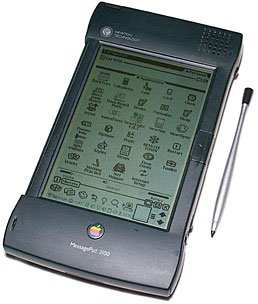 Alas, Newton, we barely knew you – which was adequately borne out by sales figures. Apple was bleeding in many areas: printers, monitors, computers (too many models), and more. It pared down the printer line, the monitor line, and the computer line.
Alas, Newton, we barely knew you – which was adequately borne out by sales figures. Apple was bleeding in many areas: printers, monitors, computers (too many models), and more. It pared down the printer line, the monitor line, and the computer line.
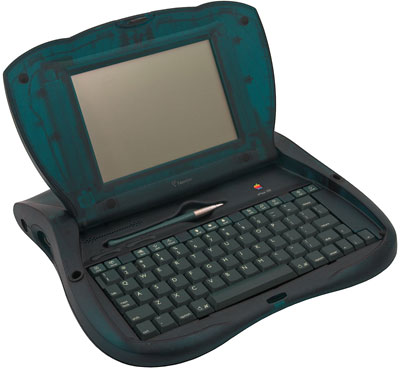 And it killed the best PDA (personal digital assistant) the world had known, the Newton. With the school-oriented eMate (a Newton laptop with a keyboard), Newton was starting to make inroads into new markets, but Apple chose to cut its losses.
And it killed the best PDA (personal digital assistant) the world had known, the Newton. With the school-oriented eMate (a Newton laptop with a keyboard), Newton was starting to make inroads into new markets, but Apple chose to cut its losses.
This set the stage for Palm to take over the PDA market – it was smaller and more affordable than Newton and already had two-thirds of the market in 1997. In 1999, Palm held 85% of the PDA market. Microsoft tried to compete with Windows CE, but it made slow progress against the dominant platform. Today these platforms are more often seen in smartphones than in dedicated PDAs.
Rumors were that some of the Newton technology would reappear in a consumer portable, which came to market as the iBook in 1999. There was no Newton technology there, although Newton’s handwriting recognition software would eventually make in into Mac OS X 10.2 as Inkwell, where it only worked with a graphics tablet.
After creating the PDA market with the Newton in 1993 and leaving it in 1998, Apple eventually returned to it with the iPhone and iPod touch starting in 2007.
OS 8.1, 8.5, 8.5.1
Mac OS 8.1 was a free maintenance upgrade to Mac OS 8 that was released in January 1998. The big improvementm was HFS+, a new filing system that allowed far more efficient use of hard drive space and for the first time supported partitions bigger than 2 GB.
The original HFS went back to the Mac Plus and System 3.2 of 1986, which needed to support drives 20 MB and larger along with nested folders. As drives grew past 100 MB or so, it became evident that HFS was wasting a lot of space because of the way it allocated space
The HFS model can handle a maximum of 65,536 blocks of data per volume. Hard drives typically use 512 byte sectors, so those blocks must be multiples of 512 bytes. For partitions up to 32 MB, the sector size and allocation block match at 512 bytes, but beyond that the allocation block jumps to two, three, or more sectors. On a 2.1 GB hard drive, the minimum allocation block was 63 sectors or 31.5 KB!
HFS+ increases the maximum number of allocation blocks by several orders of magnitude. The normal allocation for a larger hard drive was now 4 KB, which meant small files no longer tied up as much space on the hard drive.
The size of the allocation block is variable under HFS+, something Alsoft took advantage of with its $20 Plus Maker software. I used Plus Maker to convert my 2.1 GB HFS hard drive into an HFS+ drive with 512-byte allocation blocks. Since I do a lot of web work, which involves a lot of small files, I increased free space from about 430 MB to over 945 MB, more than doubling my free space!
Mac OS 8.1 gave way to 8.5, which was the first Mac OS to require a PowerPC. The PowerPC native drivers improved performance, especially over a network. Unfortunately, a rare disk bug was soon uncovered that took several months to resolve. Once Apple determined the cause of the bug, it released the Mac OS 8.5.1 update.
The other biggie under 8.5 was Sherlock, a search engine that worked as well on your local hard drive, a server volume on your network, or the Internet itself.
Power Mac and PowerBook Developments
Apple bumped the Power Mac G3 to 300 MHz in March, followed by 333 MHz and 366 MHz versions in August. The “Revision B” Beige Power Macs were aimed at the pro market even more than the Rev. A models had been. In addition to faster CPU speeds, you could buy the faster models with SCSI hard drives and a 1 MB level 2 (L2) cache.
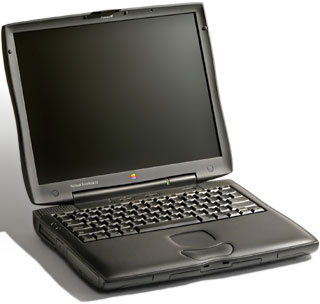 In May, Apple released a completely redesigned PowerBook G3. Code named WallStreet, the new ‘Books came in a curvy case, ranged in speed from 233 MHz to 292 MHz, had three different display options, and included two drive bays, which could hold batteries, a floppy drive, an optical drive, a Zip drive, or a hard drive. These had a 66 MHz or 83 MHz system bus, up from 50 MHz in the previous G3 PowerBook, and can support up to 512 MB of RAM (up from 160 MB in Kanga). With two batteries installed, it was possible to get 5-6 hours of field time.
In May, Apple released a completely redesigned PowerBook G3. Code named WallStreet, the new ‘Books came in a curvy case, ranged in speed from 233 MHz to 292 MHz, had three different display options, and included two drive bays, which could hold batteries, a floppy drive, an optical drive, a Zip drive, or a hard drive. These had a 66 MHz or 83 MHz system bus, up from 50 MHz in the previous G3 PowerBook, and can support up to 512 MB of RAM (up from 160 MB in Kanga). With two batteries installed, it was possible to get 5-6 hours of field time.
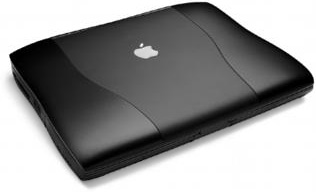 The original family of WallStreet PowerBooks wasn’t without its problems. The entry-level 233 MHz model had no L2 cache, which made it significantly slower than the 250 MHz model, and the 13.3″ display often developed problems due to the way its video cable was routed through the hinge. And speaking of hinges, the biggest flaw in the WallStreet design was the hinge – the clutch can eventually give way, which means the display won’t stay in an upright position.
The original family of WallStreet PowerBooks wasn’t without its problems. The entry-level 233 MHz model had no L2 cache, which made it significantly slower than the 250 MHz model, and the 13.3″ display often developed problems due to the way its video cable was routed through the hinge. And speaking of hinges, the biggest flaw in the WallStreet design was the hinge – the clutch can eventually give way, which means the display won’t stay in an upright position.
The iMac
The iMac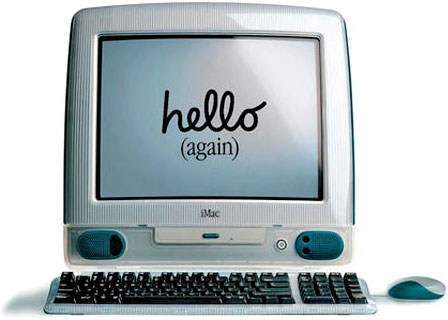 will probably take top billing as the most significant computer of 1998. Not only did it single-handedly show the world how cool Apple is, it became the top selling model for several months, drove the PC industry to finally use those USB ports they’d been building into some PCs since early 1996, and helped Apple turn an already profitable year into an incredible success.
will probably take top billing as the most significant computer of 1998. Not only did it single-handedly show the world how cool Apple is, it became the top selling model for several months, drove the PC industry to finally use those USB ports they’d been building into some PCs since early 1996, and helped Apple turn an already profitable year into an incredible success.
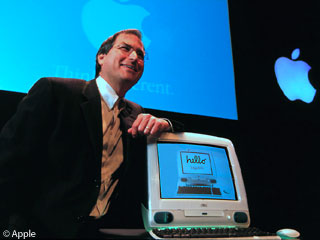 The original iMac was introduced in May and shipped in August. It had a 233 MHz G3 CPU, the same level of performance as the entry-level Power Mac G3 introduced in November 1997. The iMac had 32 MB of RAM, a 4 GB hard drive, a 24x CD-ROM, ATI Rage IIc graphics with 2 MB of video memory (expandable to 6 MB), a 15″ display, an IrDA port, and no floppy drive. This was the beginning of the end for built-in floppy drives at Apple, and the PC industry would eventually follow its lead.
The original iMac was introduced in May and shipped in August. It had a 233 MHz G3 CPU, the same level of performance as the entry-level Power Mac G3 introduced in November 1997. The iMac had 32 MB of RAM, a 4 GB hard drive, a 24x CD-ROM, ATI Rage IIc graphics with 2 MB of video memory (expandable to 6 MB), a 15″ display, an IrDA port, and no floppy drive. This was the beginning of the end for built-in floppy drives at Apple, and the PC industry would eventually follow its lead.
The iMac supported resolutions to 1024 x 768 on its CRT display, although it tended to be a bit fuzzy at that setting. Apple officially claimed the iMac could support 128 MB of RAM, but as higher capacity memory modules became available, users found that most 128 MB, some 256 MB, and even some 512 MB modules worked, giving a maximum RAM capacity of 1 GB. G3 iMacs also allow use of IDE hard drives up to 128 GB in size.
Apple updated the iMac in October. The Revision B model shipped with Mac OS 8.5, ATI Rage Pro graphics, and 6 MB of video memory. Other than that, it looked and worked just like the Rev. A model.
The Classics
On August 31, 1998, Apple discontinued all support for 68000- and 68020-based Macs, most 68030-based Macs, several LaserWriters, and the entire (long discontinued) Apple II line.
The Competition
Intel had been losing market share on the low end to AMD and others for years – even big companies like Compaq adopted non-Intel CPUs for some less expensive models. Intel addressed this with the Celeron (or, as Steve Jobs called it, Celery) processor, a Pentium II with no backside cache.
Dumb. It flopped. So Intel released Celeron II (a.k.a. Mendocino), with a built-in 128 KB L2 cache – much smaller than Pentium II’s 512 KB (don’t want to compete there), but twice as efficient than the original cacheless “Covington” Celeron.
Windows 98 finally shipped in June 1998, making Windows less Mac-like, more proprietary, and more bizarre than ever before. (Using a web browser as your OS interface? I don’t get it.)
Personal Perspective
As a longtime Apple user (Apple II+, circa 1979) and Mac lover (since I got my Mac Plus circa 1990), I was thrilled to see Apple turn a profit, have the most popular computer in the world, and quickly respond to a serious (albeit rare) bug in Mac OS 8.5.
As a longtime proponent of older Macs, I was disappointed that Apple dropped support for so many older models – but I realize they were probably carrying a lot of dead parts inventory, which this allowed them to liquidate.
The iMac led to a whole new class of website, the iMac site, of which The iMac Channel (now part of Low End Mac) was a good example. Well before the first iMac shipped, Apple fans rose up in numbers to create pages and entire sites dedicated to a decidedly revolutionary computer: new styling, new bus, same familiar Mac OS.
It was the year Low End Mac grew from a personal website into a leading resources on older Macs.
It was a very good year.
Next – 1999: Faster iMacs, Smurf and G4 Power Macs, Lombard, and the iBook
Keywords: #imac #wallstreetpowerbookg3
Short link: http://goo.gl/WdvJa3
searchword: machistory1998

